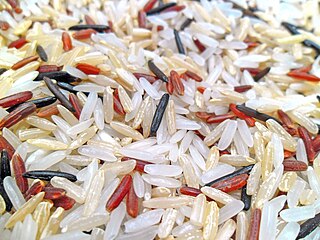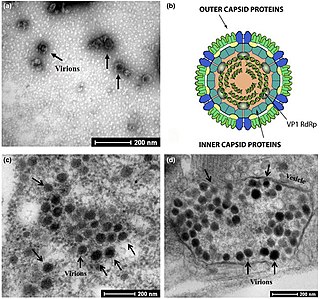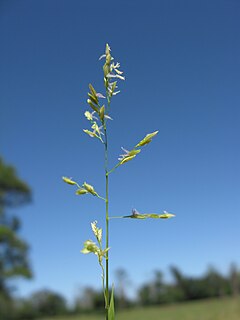
Rice is the seed of the grass species Oryza sativa or less commonly Oryza glaberrima. The name wild rice is usually used for species of the genera Zizania and Porteresia, both wild and domesticated, although the term may also be used for primitive or uncultivated varieties of Oryza.

Integrated pest management (IPM), also known as integrated pest control (IPC) is a broad-based approach that integrates practices for economic control of pests. IPM aims to suppress pest populations below the economic injury level (EIL). The UN's Food and Agriculture Organization defines IPM as "the careful consideration of all available pest control techniques and subsequent integration of appropriate measures that discourage the development of pest populations and keep pesticides and other interventions to levels that are economically justified and reduce or minimize risks to human health and the environment. IPM emphasizes the growth of a healthy crop with the least possible disruption to agro-ecosystems and encourages natural pest control mechanisms." Entomologists and ecologists have urged the adoption of IPM pest control since the 1970s. IPM allows for safer pest control.
Tick-borne diseases, which afflict humans and other animals, are caused by infectious agents transmitted by tick bites. They are caused by infection with a variety of pathogens, including rickettsia and other types of bacteria, viruses, and protozoa. Because individual ticks can harbor more than one disease-causing agent, patients can be infected with more than one pathogen at the same time, compounding the difficulty in diagnosis and treatment. 16 tick-borne diseases of humans are known, of which four have been discovered since 2013.

The brown planthopper (BPH), Nilaparvata lugens (Stål) is a planthopper species that feeds on rice plants. These insects are among the most important pests of rice, which is the major staple crop for about half the world's population. They damage rice directly through feeding and also by transmitting two viruses, rice ragged stunt virus and rice grassy stunt virus. Up to 60% yield loss is common in susceptible rice cultivars attacked by the insect. The BPH is distributed throughout Australia, Bangladesh, Bhutan, Burma (Myanmar), Cambodia, China, Fiji, India, Indonesia, Japan, North and South Korea, Laos, Malaysia, India, Nepal, Pakistan, Papua New Guinea, Philippines, Sri Lanka, Taiwan, Thailand, and Vietnam. Their alternative host plant other than rice is Leersia hexandra.
Tenuivirus is a plant virus genus belonging to Phenuiviridae family in the order Bunyavirales. These plant viruses cause diseases in their host plants. Typical symptoms are chlorotic stripes on the affected leaves. This group of viruses make viral inclusions in infected cells which can be used to diagnose infection.

Potato leafroll virus (PLRV) is a member of the genus Polerovirus and family Solemoviridae. The phloem limited positive sense RNA virus infects potatoes and other members of the family Solanaceae. PLRV was first described by Quanjer et al. in 1916. PLRV is transmitted by aphids, primarily the green peach aphid, Myzus persicae. PLRV is one of the most important potato viruses worldwide but particularly devastating in countries with limited resources and management. It can be responsible for individual plant yield losses of over 50%. One estimate suggests that PLRV is responsible for an annual global yield loss of 20 million tons. Symptoms include chlorosis, necrosis and leaf curling.
Rice hoja blanca tenuivirus (RHBV), meaning "white leaf rice virus", is a plant virus in the family Phenuiviridae. RHBV causes Hoja blanca disease (HBD), which affects the leaves of the rice plant Oryza sativa, stunting the growth of the plant or killing it altogether. RHBV is carried by an insect vector, Tagosodes orizicolus, a type of planthopper. The virus is found in South America, Mexico, throughout Central America, the Caribbean region, and the southern United States. In South America, the disease is endemic to Colombia, Venezuela, Ecuador, Peru, Suriname, French Guiana and Guyana.

Fijivirus is a genus of double-stranded RNA viruses in the family Reoviridae and subfamily Spinareovirinae. Plants serve as natural hosts. Diseases associated with this genus include: galls (tumours) in infected plants and Fiji disease, with severe stunting, deformation and death. The group name derives from Fiji island the place where the first virus was isolated. There are nine species in this genus.

Cucumber mosaic virus (CMV) is a plant pathogenic virus in the family Bromoviridae. This virus has a worldwide distribution and a very wide host range. In fact it has the reputation of having the widest host range of any known plant virus. It can be transmitted from plant to plant both mechanically by sap and by aphids in a stylet-borne fashion. It can also be transmitted in seeds and by the parasitic weeds, Cuscuta sp. (dodder).
Potato virus Y (PVY) is a plant pathogenic virus of the family Potyviridae, and one of the most important plant viruses affecting potato production.
Soil-borne wheat mosaic virus is a rod-shaped plant pathogen that can cause severe stunting and mosaic in susceptible wheat, barley and rye cultivars. The disease has often been misdiagnosed as a nutritional problem, but this has actually allowed in part for the fortuitous visual selection by breeding programs of resistant genotypes. Soil-borne wheat mosaic virus is part of the genus Furovirus. Members of this genus are characterized by rigid rod-shaped particles and positive sense RNA genomes consisting of two molecules that are packaged into separate particles that code for either replication, mobility, structure or defense against the host. The virus is spread by a fungal-like protist, Polymyxa graminis, whose asexual secondary and sexual primary cycles help the virus spread. The disease produces secondary symptoms from the root cell infection. The disease is a serious contributor to loss in crop yield.
Rice ragged stunt virus (RRSV) is a plant pathogenic virus of the family Reoviridae.
Rice stripe tenuivirus is an RNA plant pathogen of the genus Tenuivirus. It is prevalent in Japan, China, and Korea and can infect plants of the family Poaceae, which include wheat and corn. Damage from this disease causes major reductions in rice crop yield every year.
Rice yellow mottle virus (RYMV) is a plant pathogenic virus, belonging to the genus Sobemovirus. The genome is a positive-sense single strand RNA of 4450 nucleotides in length and is not polyadenylated. It was first reported in Kenya in 1966 in one of Africa's first cultivation intensification schemes, due to RYMV's association with intensification, but DNA analysis of its evolutionary history shows it to have evolved in East Africa in the 19th century. Since its identification in Kenya it has been detected in many countries in sub-Saharan Africa. It has also been detected in Central Africa, but has yet to be seen outside the continent. The genomic organization of RYMV is most similar to that of Cocksfoot mottle sobemovirus. RYMV is one of the better-studied plant-virus pathosystems.

Sugarcane grassy shoot disease (SCGS), caused by ‘Candidatus Phytoplasma sacchari’ which are small, pleomorphic, pathogenic bacteria that contributes to yield losses from 5% up to 20% in sugarcane. These losses are higher in the ratoon crop. A higher incidence of SCGS has been recorded in some parts of Southeast Asia and India, resulting in 100% loss in cane yield and sugar production.

Leersia hexandra is a species of grass known by the common names southern cutgrass, clubhead cutgrass, and swamp rice grass. It has a pantropical distribution. It is also an introduced species in many regions, sometimes becoming invasive, and it is an agricultural weed of various crops, especially rice. It is also cultivated as a forage for livestock.
Oryzavirus is a genus of double-stranded RNA viruses in the family Reoviridae and subfamily Spinareovirinae. Member viruses infect plants and are transmitted by planthoppers. Diseases associated with this genus include: rice stunting, enations on veins of leaves and leaf sheaths, ragged leaves, and flower suppression. There are two species in this genus.
Tungrovirus is a genus of viruses, in the family Caulimoviridae, order Ortervirales. Monocots and family Poaceae serve as natural hosts. There is only one species in this genus: Rice tungro bacilliform virus. Diseases associated with this genus include: stunting, yellow to orange leaf discoloration with fewer tillers. Tungro means 'degenerated growth' in a Filipino dialect and the virus was first observed in the Philippines 1975.
The Ramu stunt disease is a disease of the sugarcane widespread throughout Papua New Guinea, but not detected in Australia. Eumetopina flavipes, the island sugarcane planthopper, is a species of planthopper present throughout South East Asia which is a vector for the disease.






